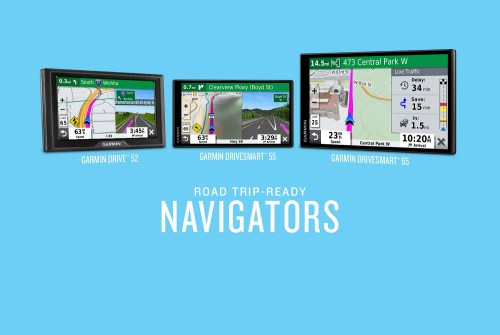
Standalone GPS units face life-threatening competition from smartphone apps like Google Maps, and from the navigation systems that are increasingly built into a car’s infotainment system. Garmin still believes the old-school GPS has a bright future. The firm traveled to CES 2019 to reveal its updated line of Drive navigators packed with new, road trip-friendly features.
More CES 2019 coverage
- Toyota rolls out an updated autonomous car prototype
- Hyundai’s Elevate ‘walking car’ can climb over rough terrain
- TomTom debuts end-to-end autonomous driving system
The 2019 Garmin Drive lineup includes four models with a 5.0-, 5.5-, or 6.95-inch display. Regardless of size, the high-resolution screen provides accurate, turn-by-turn directions with 3D buildings and terrain information. For example, the Drive might say “turn left at the city hall after the traffic light” instead of instructing the driver to “turn left on 500 South.” This feature takes a lot of the guesswork out of getting from point A to point B in a city you’ve never driven in before.
That’s what we’ve come to expect from standalone GPS units in 2019, though. Garmin’s Drive units go above and beyond by giving road-tripping motorists information about noteworthy places they’ll drive past (or through) during their trip. Users can access a directory of the national parks in the United States, information about notable sites provided by the History Channel, points of interest from FourSquare, and the TripAdvisor rating of thousands of monuments, restaurants, and hotels. Finally, to lure adventurers, every member of the Drive family provides the location of visitor centers, picnic areas, campgrounds, and trailheads in national parks. This information is programmed directly into the device so it’s accessible regardless of whether or not there is a reliable data connection.
The user-friendly features that helped Garmin’s GPS units survive the app blitz remain. They’re still intuitive to use, they boast voice-recognition technology, and some models even provide real-time traffic information. The more advanced (and, inevitably, more expensive) devices stand out by sending drivers alerts, like when they need to slow down because they’re in a school zone, or when they’re about to drive under a red-light camera.
Garmin’s new GPS units will go on sale nationwide in January 2019. The lineup includes the 52 — which is available with or without traffic information –, and a pair of always-online units called 55 and 65, respectively. Pre-tax pricing ranges from $150 to $270.
Garmin can’t stay entirely smartphone-free, however. The 55 and 65 devices pair with a smartphone app named Garmin Drive that provides live traffic information, parking information, and other useful notifications via Bluetooth. Garmin Drive also gives motorists access to photos from over 10,000 strategically-located traffic cameras across the nation to let them check weather and traffic conditions.